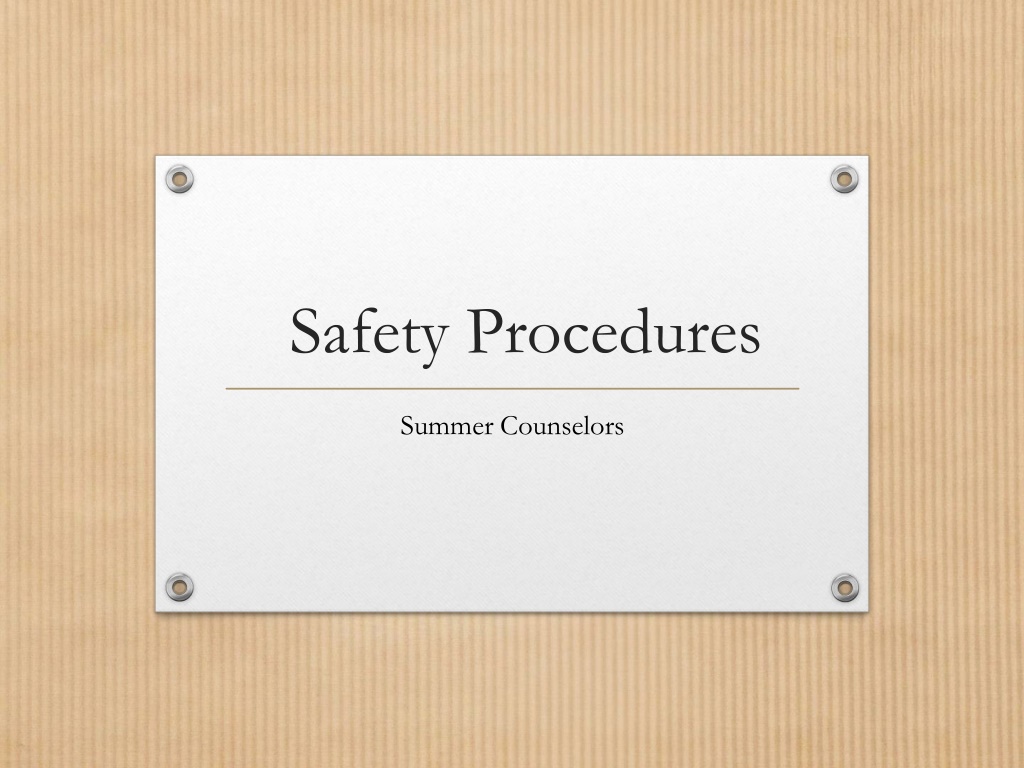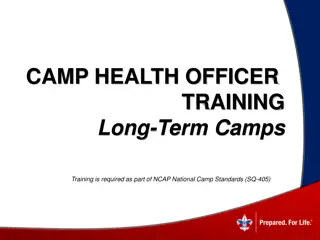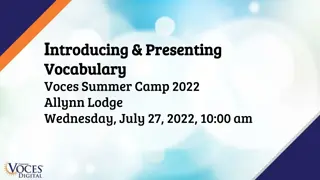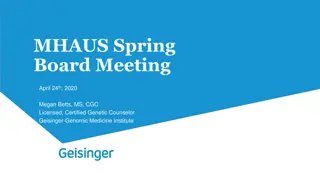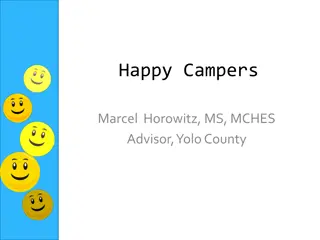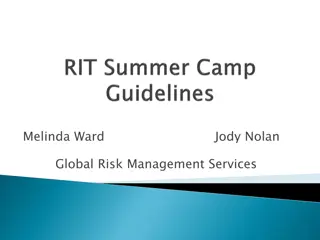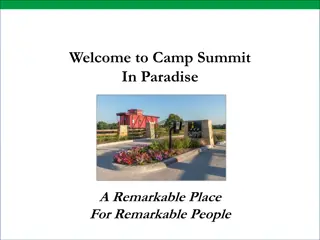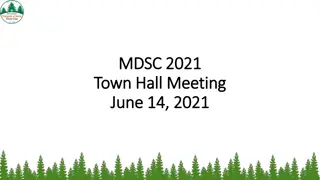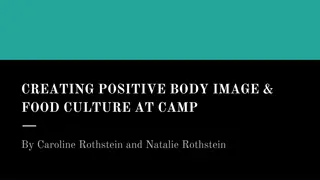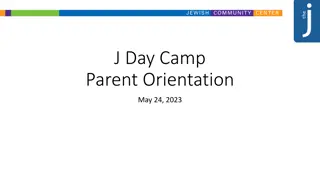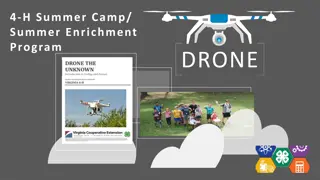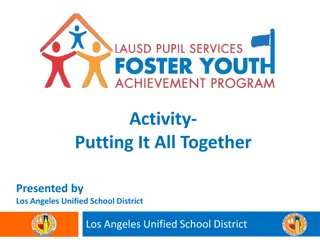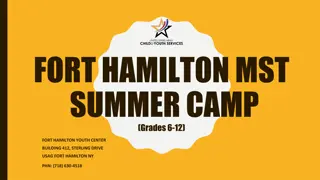Summer Camp Safety Procedures for Counselors
Explore essential safety procedures and emergency preparedness guidelines for summer camp counselors. Learn about evacuation protocols, accounting for missing individuals, assembly areas, and more through detailed visual aids and informative slides.
Download Presentation

Please find below an Image/Link to download the presentation.
The content on the website is provided AS IS for your information and personal use only. It may not be sold, licensed, or shared on other websites without obtaining consent from the author.If you encounter any issues during the download, it is possible that the publisher has removed the file from their server.
You are allowed to download the files provided on this website for personal or commercial use, subject to the condition that they are used lawfully. All files are the property of their respective owners.
The content on the website is provided AS IS for your information and personal use only. It may not be sold, licensed, or shared on other websites without obtaining consent from the author.
E N D
Presentation Transcript
Safety Procedures Summer Counselors
Emergency Preparedness Evacuate or Shelter in Place
Accounting for missing people in an evacuation Do you need to account for anyone? Who needs to account for you?
Assembly Areas
Shelter in Place Events Chemical, Biological, Or Radiological Contaminants Severe Weather Active Shooter Or Armed Suspect
Chemical, Biological, Or Radiological Contaminants Best place to go?
Chemical, Biological, Or Radiological Contaminants http://www.nationalterroralert.com/shelterinplace/ Go to an interior room without windows that s above ground level. Close all windows and exterior doors. If there is danger of explosion, close the window shades, blinds, or curtains. Turn off all fans, heating and air conditioning systems.
Severe Weather Best place to go?
Severe Weather Tornado Example https://www.osha.gov/dts/weather/tornado/preparedness.html Seek a small interior room or hallway on the lowest floor possible Stay away from doors, windows, and outside walls Stay in the center of the room, and avoid corners because they attract debris Rooms constructed with reinforced concrete, brick or block with no windows and a heavy concrete floor or roof system overhead Avoid auditoriums, cafeterias and gymnasiums that have flat, wide- span roofs.
Active Shooter Or Armed Suspect Best place to go?
Active Shooter Or Armed Suspect https://www.dhs.gov/xlibrary/assets/active_shooter_b ooklet.pdf If you are in an office or classroom, stay there and secure the door If you are in a hallway, get into a room and secure the door Avoid windows and other highly visible locations
Injuries and Illnesses When treatment beyond first aid is needed
Illness/Injury treatment beyond first aid required First report of injury for employees Incident report for non-employees ehs.cua.edu Workplace Safety
Pre-employment screening Contact Andrea Daniels
Protecting children from sexual misconduct training https://learn.ue.org/VE5CA791996/ CUAProtectingChildren#Register Must be completed prior to the start of camp
Key take-away understandings: Identify warning signs Remember who to report misconduct within your department and the reporting requirements Contact the Department of Public Safety for any emergency situation at 202-319-5111
Who to report to? Supervisor Frank Vinik Title IX Coordinator Leahy 170, Human Resources tel. 202-319-4177 titleix-coord@cua.edu DPS ext. 5111
Medical Care Student Health Center is NOT available to camps. Health forms must be immediately available to camp staff to give to emergency responders at any time, but not accessible to others. Call Public Safety for an ambulance, x5111.
Urgent Care Centers in the D.C. Metropolitan Area Farragut Medical and Travel Care DC Immediate and Primary Care 815 Connecticut Avenue, NW Cleveland Park Washington, DC 20006 2902 Porter Street NW 202-775-8500 Washington DC 20008 Hours: Monday-Friday 10am-5pm 202-525-5287 * walk ins until 4pm only Hours: M-F 8am-8pm Sat/Sun 8am-6pm
Urgent Care Centers in the D.C. Metropolitan Area Medstar PromptCare Mid Atlantic Urgent Care Center Adams Morgan 3301 Wilson Boulevard 1805 Columbia Road, NW Arlingtpn VA 22201 Washington DC 20009 703-243-6720 202-797-4960 *near Virginia Square Metro M-F 9am-8pm M-F 9am-7:30pm Sat/Sun/holidays 9am-8pm Saturday 9am-5:30pm Medstarhealthcare.prg Sunday 10am-4:30pm *online check-in available
for the hours and location of the nearest Minute Clinic please see their web site at: http://minuteclinic.com/en/USA/Clinics.aspx Urgent Care Centers in the D.C. Metropolitan Area Medics USA Minute Clinic at CVS Columbia Heights for the hours and location of the nearest Minute Clinic please see their web site at: 2750 14th St. NW http://minuteclinic.com/en/USA/Clinics. aspx Washington, DC 20009 202-595-8813 Hours: M-F 9am-6pm
Camper Medications DO NOT carry or administer medication for campers DO say something if you see: Medication is being shared or distributed. Campers have brought noticeably more medication than would be needed for the duration of the camp. Medications (prescription or OTC) are not in their original container, labeled with the Camper s name, name of the medication, dosage, frequency of administration, and prescribing physician s name and phone number. Campers have medication at camp without having completed the Authorization for Self-Carry and Self-Administration of Medication form.
Summary 1. Emergency Preparedness Evacuation Routes Shelter in Place Best Practices HazMat Situations Severe Weather Active Shooter/Suspect Injury reporting Employees Non-employees 2. Pre-employment Screening 3. Protecting Minors from Sexual Misconduct Training 4. Medical Care 5. Camper Medications
Questions? walters@cua.edu 202-319-5865
